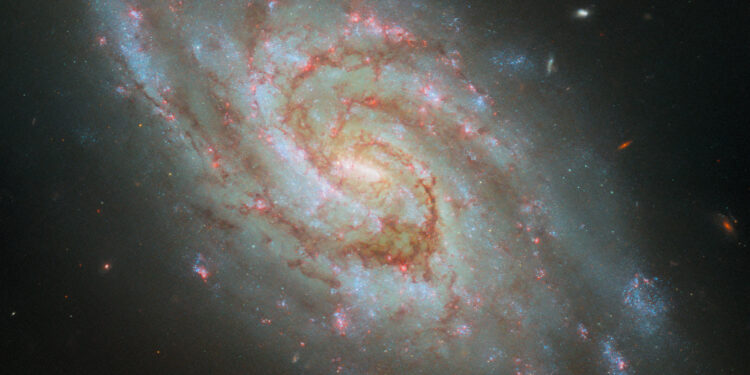This image from the NASA/ESA Hubble Space Telescope shows the spiral galaxy IC 1954. Credit: ESA/Hubble & NASA, D. Thilker, J. Lee and the PHANGS-HST team
This NASA/ESA Hubble Space Telescope image depicts the spiral galaxy IC 1954, located 45 million light-years from Earth in the Horologium constellation. It sports a bar of light at its center, majestically coiled spiral arms, and clouds of dark dust flowing across it. Many of the bright, pink spots across the galaxy’s disk are H-alpha regions that offer astronomers a view of star-forming nebulae, which are prominent emitters of red H-alpha light.
Some astronomers hypothesize that the galaxy’s “bar” is actually an energetic star-forming region that sits just above the galactic center.
The data shown in this image come from a program that extends cooperation between several observatories: Hubble, the James Webb Infrared Space Telescope, and the Atacama Large Millimeter/submillimeter Array, a ground-based radio telescope. By studying IC 1954 and more than 50 other nearby galaxies in radio, infrared, optical and ultraviolet light, astronomers aim to retrace and completely reconstruct the path taken by matter through stars, mapping interstellar gas and dust in every galaxy.
Hubble’s observational capabilities are an important part of this study: it can capture younger stars and star clusters when they are brightest in ultraviolet and optical wavelengths, and its H-filter alpha effectively tracks emissions from nebulae. The resulting data set will constitute a treasure trove of research on the evolution of stars in galaxies, which Webb can draw on to continue his scientific operations in the future.
Quote: Hubble captures star nurseries in the majestic spiral galaxy IC 1954 (September 30, 2024) retrieved October 1, 2024 from
This document is subject to copyright. Except for fair use for private study or research purposes, no part may be reproduced without written permission. The content is provided for informational purposes only.



